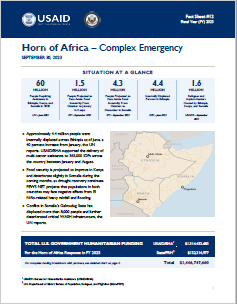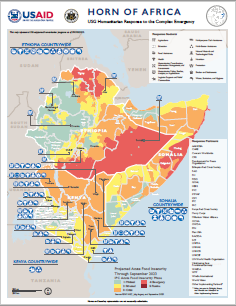Horn of Africa
USAID is responding to the Horn of Africa's most prolonged drought in recent history, affecting more than 19 million people. Photo credit: YASUYOSHI CHIBA / AFP
Populations across Ethiopia, Kenya, and Somalia face the confluence of recurring climatic shocks, widespread food insecurity, and reduced access to livelihoods. These ongoing challenges, exacerbated by persistent conflict and resultant displacement, contribute to sustained humanitarian needs and ongoing complex emergencies. Persistent dry weather in parts of Ethiopia, Kenya, and Somalia, with four consecutive seasons of poor rainfall between 2020 and 2022, has led to the most severe drought on record in the Horn of Africa in the last 40 years. Critical water shortages in drought-affected areas have significantly undermined livestock conditions, livelihoods, and food security. Meanwhile, intercommunal conflicts in Ethiopia have generated displacement, exacerbated humanitarian needs, and impeded humanitarian access since 2018. In Somalia, ongoing conflict—related to al-Shabaab attacks and resultant military operations, as well as intercommunal violence—continues to contribute to displacement and food insecurity, while restricting access to livelihoods. Sustained life-saving assistance, coupled with interventions aimed at building resilience, is critical to help conflict-affected households meet basic needs and rebuild assets.
USAID responded to heightened food and nutrition needs resulting from drought in Ethiopia between 2015 and 2018, as well as drought in Kenya and Somalia between 2016 and 2018.



